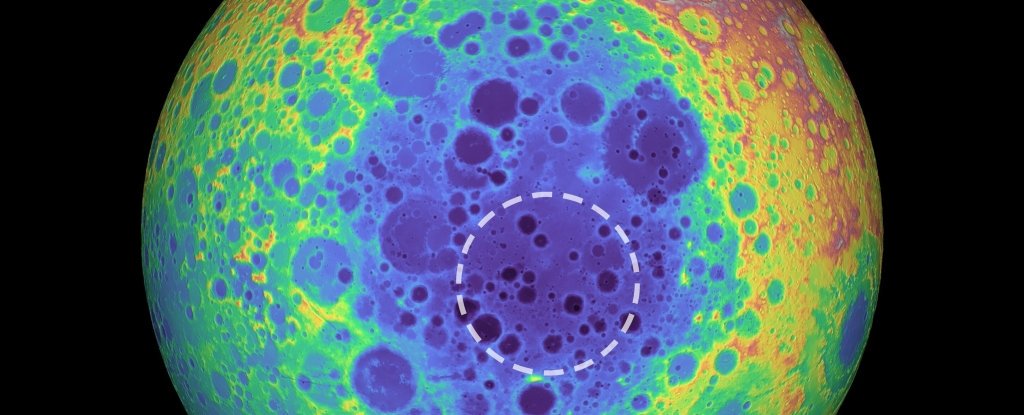(Michelle Starr) The Moon is home to one of the largest known impact craters in the Solar System. At 2,500 kilometres (1,550 miles) across, the South Pole-Aitken Basin on the Moon’s far side covers nearly a quarter of the lunar surface – and there’s something massive buried beneath it.
Related Why Saturn’s Moon Iapetus Could Have Been Artificially Made By Extraterrestrials
by Michelle Starr, June 11th, 2019
We can’t see it from here on Earth, but detailed readings made using lunar orbiters indicate there is something huge enough under that crater to be causing a significant gravitational anomaly.
“Imagine taking a pile of metal five times larger than the Big Island of Hawaii and burying it underground,” said geophysicist Peter James of Baylor University.
“That’s roughly how much unexpected mass we detected.”
The anomaly was discovered in two sets of data. The first was from NASA’s GRAIL mission, a pair of orbiting spacecraft that mapped the Moon’s gravitational field in 2011 and 2012 to try to shed some light on its interior structure.
This data had already indicated a gravitational anomaly, and that the basin had higher-than-average density compared to the rest of the lunar surface; the team attributed this to its iron-rich surface composition.
But when the team compared these findings with the lunar topography data collected by NASA’s Lunar Reconnaissance Orbiter, the results showed something else: a mass of about 2.18 quintillion kilograms (that’s a number with 18 zeroes), extending more than 300 kilometres (184 miles) below the surface.
This mass, the researchers believe, is weighing the floor of the basin downward by more than 800 metres, around 10 percent of its total depth, explaining a depression in the bottom of the basin previously attributed to contraction.
Buy Book Somebody Else Is On The Moon
“One of the explanations of this extra mass,” James said, “is that the metal from the asteroid that formed this crater is still embedded in the Moon’s mantle.”
According to computer simulations, if conditions are just right, the iron-nickel core of an impacting asteroid can be dispersed into the upper mantle, between the Moon’s crust and core.
This is what could have happened 4 billion years ago, when the object that created the basin slammed into the Moon.
“We did the maths and showed that a sufficiently dispersed core of the asteroid that made the impact could remain suspended in the Moon’s mantle until the present day, rather than sinking to the Moon’s core,” James said.
Another possible explanation has to do with volcanism, of which the Moon was once a hotbed. There is a high concentration of titanium oxides in the lunar mantle, thought to have been produced by the cooling and solidification of oceans of lunar magma.
Buy Book Dark Mission: The Secret History of NASA
These oxides have a great deal of mass, which somehow could have been concentrated beneath the South Pole-Aitken Basin (although that ‘somehow’ is yet to be explored).
Whatever the explanation, the mass reveals some interesting things about the Moon’s interior. For instance, we know that it’s not molten enough for the mass to sink to the centre.
If the mass is from around the same time as the impact that made the basin, this implies an upper temperature limit of around 1,480 degrees Celsius for the latter half of the Moon’s lifespan, consistent with estimates based on seismology.
This also implies that the Moon has lost a whole lot of thermal energy across its lifespan, the team said. Maybe China’s Yutu2 rover, currently crawling across the South Pole-Aitken Basin, can shed more light on the matter.
The research has been published in Geophysical Research Letters.
Stillness in the Storm Editor: Why did we post this?
The preceding information is a news update. In general, staying informed as to events taking place is essential as an individual because it helps you navigate the world, and socially because you can gain and maintain rapport with your fellows. This rapport can be used to share information that can help others and improve the conditions of humanity in general. However, one must learn how to exercise discernment and proper critical thinking so they can make effective use of information gained.
– Justin
Not sure how to make sense of this? Want to learn how to discern like a pro? Read this essential guide to discernment, analysis of claims, and understanding the truth in a world of deception: 4 Key Steps of Discernment – Advanced Truth-Seeking Tools.
Stillness in the Storm Editor’s note: Did you find a spelling error or grammar mistake? Send an email to [email protected], with the error and suggested correction, along with the headline and url. Do you think this article needs an update? Or do you just have some feedback? Send us an email at [email protected]. Thank you for reading.
Source:
https://www.sciencealert.com/there-s-a-huge-unexplained-mass-under-a-giant-crater-on-the-moon

Or it could be Lunar Operations Command, and they are literally disclosing it to us and authorizing it’s continued seclusion from humanity by the amount of ignorance and ego people display when it comes to conspiracies dealing with advanced technologies.